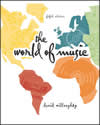|
 |  The World of Music, 5/e David Willoughby
Jazz in America
Chapter 6:
| Jazz in America and throughout the world | Jazz is a twentieth-century American phenomenon. It has a strong following in continental Europe, Japan, Africa, South America, Canada, and elsewhere. Jazz has been to a large extent an art form created by black people and performed by black people.
|  |  |  | | Chronology | The history of modern jazz style begins with New Orleans jazz in the second decade of the twentieth century. New Orleans jazz emerged in Chicago in the 1920s, largely through the music of the transplanted New Orleans musicians. It evolved into the first widely popular jazz style, Dixieland. Eventually because of the Depression, Stride became popular. The stride style was the first jazz form to feature solo pianists. Also, Boogie woogie was the 12-bar blues form combined with a unique style of piano playing. The swing era of the 1930s and early 1940s brought the only style of jazz that became popular with the masses. Jazz in the swing era into three categories: Sweet swing, the jazz of Benny Goodman, and hot swing or big band jazz. Bebop began in the early 1940s in New York City. Because the bop of the 1940s and 1950s was complex and sophisticated, it never achieved widespread popularity with the public or even among jazz musicians. Immediately, musicians began to explore alternatives. Many styles and influential artists emerged in the 1950s and the 1960s, a period of diversity in the history of jazz. Four of these important jazz styles are cool jazz, hard bop, funk, and free jazz. Modern jazz began in the mid-1960s with Miles Davis. In 1970s and 1980s many fusion artists synthesized the jazz style with pop, classical, or rock styles, creating a new jazz genre that is referred to fusion jazz. The styles of jazz today are extremely varied, ranging from the easy-listening electronic jazz of many contemporary musicians to the extremely complex post-bop jazz of many others.
|  |  |  | | Styles and techniques | To be jazz, the music swings. The musicians improvise. The rhythm is syncopated. Although jazz emphasizes syncopated, or offbeat, rhythms, not all jazz has such rhythms. Music is played on certain instruments, such as the saxophone, trumpet, trombone, drums, bass, and piano.
|  |  |  | | Swing | A manner of performance that, in part, separates jazz from other styles of music. It is a manner that generates heightened energy and rhythmic vitality.
|  |  |  | | Instruments and instrumental combinations | Music is played on certain instruments, such as saxophone, trumpet, trombone, drums, bass, and piano. Jazz is also played on the flute, tuba, organ, harp, and other instruments that are not common in jazz performance. Groups of instruments are known as sections: the rhythm section (piano, bass, and drums), the brass sections (trumpets and trombones), and the sax section (traditionally two altos, two tenors, and one baritone). A common jazz combo adds one or more lead instruments to the rhythm section: trumpet and tenor or alto sax are most common. Sometimes we find trombone, clarinet, vibraphone, flute, soprano sax, baritone sax. In modern jazz, groups often add a percussionist to play a variety of instruments such as bongos, claves, and castanets to add color and vitality to the rhythm. The conventional piano is often replaced by the electric piano, synthesizer, and MIDI technology or a combination of electric and nonelectric (acoustic) keyboard instruments. The electric organ occasionally is used.
|  |  |  | | Jam session | Where jazz musicians gather, usually “after hours,” to improvise and enjoy making music. Because the musicians are not obligated to an employer or a paying audience, they have the freedom to explore and share their musical ideas.
|  |  |  | | Sidemen | The musicians that accompany the main performer.
|
|
|



 2003 McGraw-Hill Higher Education
2003 McGraw-Hill Higher Education

 2003 McGraw-Hill Higher Education
2003 McGraw-Hill Higher Education